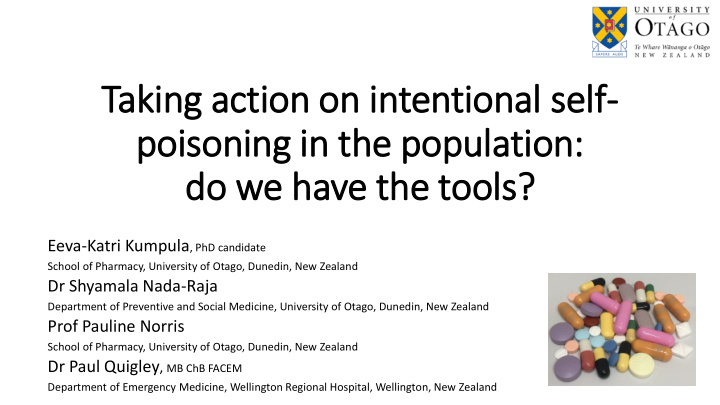



Taking action on in intentional self lf- poisoning in in the population: do we have the tools? Eeva-Katri Kumpula , PhD candidate School of Pharmacy, University of Otago, Dunedin, New Zealand Dr Shyamala Nada-Raja Department of Preventive and Social Medicine, University of Otago, Dunedin, New Zealand Prof Pauline Norris School of Pharmacy, University of Otago, Dunedin, New Zealand Dr Paul Quigley , MB ChB FACEM Department of Emergency Medicine, Wellington Regional Hospital, Wellington, New Zealand
Structure of presentation • Background: intentional self-poisoning in New Zealand • Methods: NZ National Minimum Dataset (NMDS) data • Results: specific drugs in NMDS data • Conclusion • Acknowledgements
Background • Intentional self-poisoning (ISP): a common form of self-harm ▪ Self-harm: 176.7 per 100,000 population (2013 rate, NZ Ministry of Health, 2016) ~65% ISP ~115 per 100,000 ▪ Australia 2010/2011: ~100 per 100,000 hospitalisations due to ISP (public + private; AIHW 2014) • Overall case fatality rate low, but ISP causes significant population morbidity and health resource usage • Some ISP injury events covered by the NZ national personal injury cover, Accident Compensation Corporation (ACC) • Interventions to reduce ISP need to be informed by reliable data about population groups at risk and the substances used LIMITING INAPPROPRIATE ACCESS
Methods • MOH mortality (2000-2012) and morbidity (National Minimum Dataset, NMDS, public hospitals, stays 24h+, 2000-2014) data International Statistical Classification of Diseases 10th Revision (ICD- 10) codes X60-X69 (intentional poisoning) and Y10-Y19 (poisoning of undetermined intent, UDP) ▪ Some UDP cases may be ISP • Analysed by demographic groups • Level of detail about poisoning agents nine most commonly seen overdose agents at Wellington ED used as ‘indicators’
Results • Men particularly at risk of fatal ISP and UDP • Women, young people, Māori, and those living in low -decile areas particularly at risk of non-fatal ISP and UDP • No details available about the poisoning agents involved in two thirds of deaths in the investigated mortality data • Public hospital presentation data only had ICD-10 groups of the main toxicants: most frequently non-opioid analgesics (X60+Y10), psychotropics (X11+Y11)
• Public hospital presentations: ‘indicator substances’ mostly not identifiable due to ICD-10 group structure Indicator identifiable Substance group % of cases separately? 4-Aminophenol derivatives (Paracetamol; T39.1) Paracetamol YES 29% Benzodiazepines (T42.4) Clonazepam, diazepam NO 19% Ethanol (T51.0) 19% Other and unspecified antidepressants (excl. Citalopram, fluoxetine NO MAOI; T43.2) 18% Other antiepileptic and sedative-hypnotic drugs (T42.6) Zopiclone NO 18% Other and unspecified antipsychotics and Quetiapine NO neuroleptics (T43.5) 13% Codeine NO Other opioids (T40.2) 10% NSAID (excl. salicylates; T39.3) Ibuprofen NO 10%
Conclusions • To reduce harm such as ISP by poisoning agents restricting inappropriate access: prescribing practices and over-the-counter availability • Interventions cannot be planned for whole ICD-10 groups for practical reasons nationwide, systematic collection of substance-level data is needed to monitor ISP trends and to inform policy planning for ISP prevention • Data collection at point of care: ED – automatic pop-up windows • SNOMED CT
Acknowledgements • PhD supervisors Prof Pauline Norris and Dr Shyamala Nada-Raja • Collaborator and mentor Dr Paul Quigley • New Zealand Ministry of Health – Manatū Hauora data used in this study • Financial support: • PhD stipend from the School of Pharmacy • consumables support from School of Pharmacy and Department of Preventive and Social Medicine • Dean’s Fund Grant from School of Pharmacy • Conference trip funding from School of Pharmacy, Division of Health Sciences (UO), Maurice and Phyllis Paykel Conference Travel Funding
Recommend
More recommend